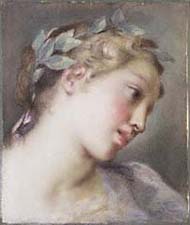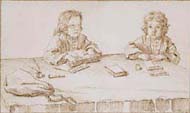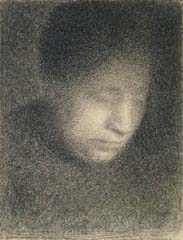 |

 |
 |
A Muse, Rosalba Carriera, mid-1720s
Recent Acquisition
|
 |
Drawing the human head was a hard-won skill that most artists practiced throughout their careers. In addition to mastering the face's physical aspects, artists confronted the more difficult tasks of mastering facial expressions and conveying personality. Leonardo da Vinci maintained that an artist's greatest challenge was to capture a person's moti mentali (motions of the mind). Since the Renaissance, artists have taken up this challenge to create effective characters and living presences in their narrative paintings and portraits.
Some of the drawings in this exhibition were preparatory works for larger paintings, and others were independent works of art. Portrait drawings, prized for their intimacy, were commissioned and collected from an early date, while so-called fancy portraits, or idealized heads, were sought after as personifications of human beauty or the passions.
|
 |
|
Famous throughout Europe for her portraits and teste di fantasia (fanciful renderings of beautiful women in allegorical or mythological guise), Rosalba Carriera made the pastel, above, at the ducal court in Modena, Italy. Augustus III, elector of Saxony and king of Poland, bought this drawing and more than 100 other pastel teste di fantasia from the artist. These works, displayed together in his palace in Dresden, must have been an astonishing exhibition of Carriera's technique in the service of ideal female beauty.
|
 |
|
Giovanni Battista Piazzetta's large finished drawings of heads, such as this sheet, were widely sought after by contemporary collectors and provided a steady source of income for the artist. Although most of these works were meant to represent human types or expressions, some of them are portraits of specific people. The artist's son Giacomo may have been the model for the boy in this drawing.
|
 |
|
Although she does not appear in any of his paintings, this robust woman is a figure type often seen in Jacob Jordaens's works. The artist first used black and red chalk to articulate her features and disheveled hair, then added flourishes with wash and gouache on her hair, eyes, and forehead. Jordaens was a prolific draftsman, and this drawing was probably among the studies he kept for reference in his large and productive workshop.
|
 |
|
This drawing is an example of a portrait historié (a specific person depicted in imaginary or historical costume). The naturalistic depiction of the man's face—warts and all—suggests that Hendrick Goltzius drew the man from life, despite his old-fashioned hat and coat, which date from the 1500s. The sitter may have preferred 16th-century art and asked Goltzius to imitate that style for his portrait.
|
 |
 |

 |
 |
Portraits of Serafino and Francesco Falzacappa, Pier Leone Ghezzi, about 1720
Recent Acquisition
|
 |
Pier Leone Ghezzi had recently received an important commission for an altarpiece from the Falzacappa family when he made this portrait of two young brothers, who are identified by the papers on the table. The boys are portrayed as though they have been interrupted from their lessons, lending immediacy to this precisely drawn work. In addition to his renown as a painter of naturalistic, informal portraits, Ghezzi was also known for his caricatures.
|
 |
|
Maurice-Quentin Delatour made this lively drawing of the painter Louis de Silvestre (French, 1675–1760) as a study for a large pastel portrait commemorating Silvestre's appointment as director of the Royal Academy of Painting and Sculpture. The two artists were friends, and Delatour created a mood of intimacy and informality by showing the painter at work, as indicated by his blue headcovering and by the sympathetic and frank recording of every line of the artist's face.
|
 |
|
While living in Arles, Vincent van Gogh made eight portraits—three drawings and five paintings—of his friend and neighbor Joseph Roulin. This drawing particularly captures the "salient gravity and a tenderness toward me" that so endeared Roulin to the artist. Using patterns of thick and thin lines to create a remarkable surface energy, van Gogh presented Roulin with a presence that seems barely contained by the margins of the sheet.
|
 |

 |
 |
Madame Seurat, the Artist's Mother, Georges Seurat, about 1882-83
Recent Acquisition
|
 |
 |
Portraits were very personal productions for Georges Seurat; all of his known portraits depict family and friends. In this technically complex drawing, the artist showcased his intimate style in rendering a personal subject, portraying his mother as a monumental and mysterious presence. Seurat modeled the simplified forms of her head and body without lines, using subtle gradations of black and deftly allowing areas of the highly textured white paper to show through the design.
|
 |